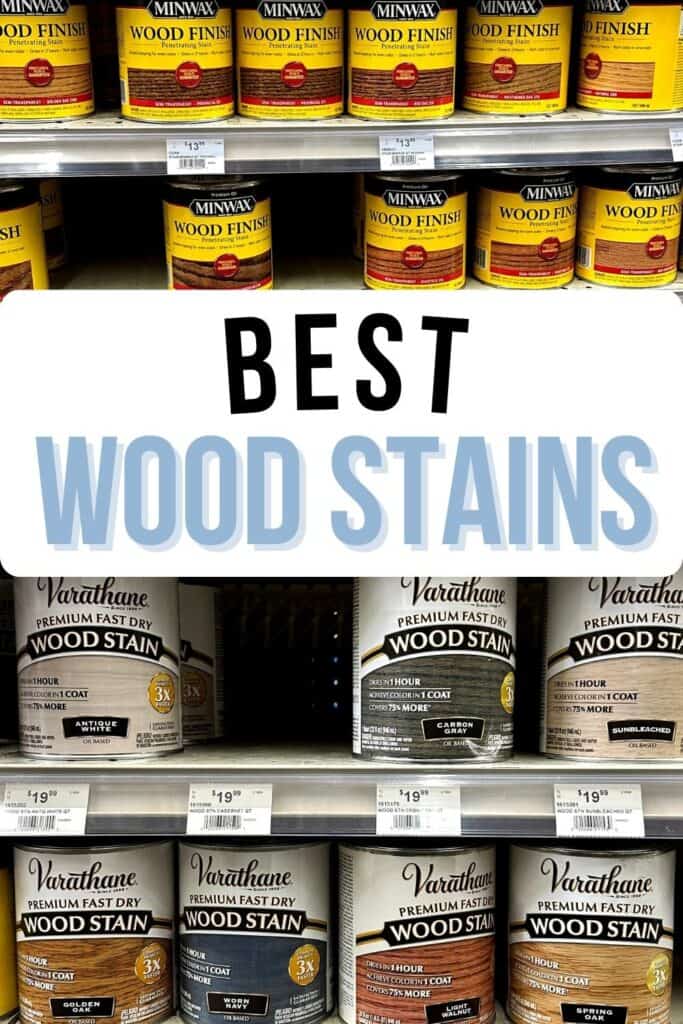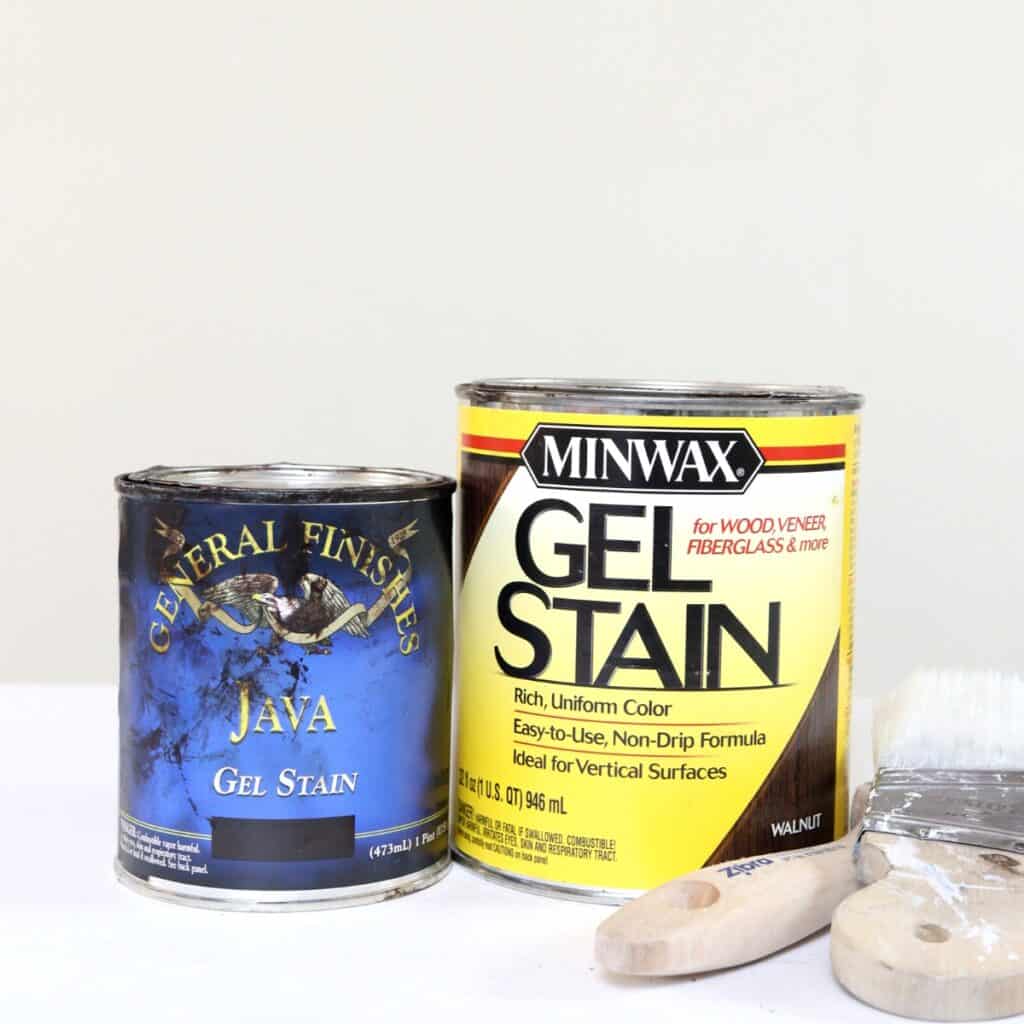Best Wood Stains for Refinishing Furniture
With a wide range of stains available, it can be tough to know what the best wood stain is for your furniture refinishing project. From oil-based stains to water-based and gel options, each has its own advantages and disadvantages.
In this article, we’ll explore what type of wood stain is best suited for different pieces of furniture and how to select the right one for your refinishing furniture needs. We’ll also discuss some common mistakes people make when staining their furniture so that you can avoid them.

To ensure that you get the best results possible with your project, it’s important to understand the pros and cons of each type of wood stain so that you can select the right one for your needs.
So let’s dive into the types of wood stain that you can choose from.
Types of Wood Stain
Oil-based stains are the traditional type of wood stain used for furniture refinishing. They need a longer drying time, but they can provide a deep, rich color that is resistant to fading.
Oil-based stains also offer more durability and protection from moisture, making them a good choice for outdoor furniture and other projects that may be exposed to moisture or extreme temperatures.
Water-based stains are becoming increasingly popular due to their convenience and easy cleanup.
They can provide a similar color and effect as oil-based stains, but they dry much faster and they don’t have the fumes associated with the oil-based products.
Gel stains offer a thick, gel-like consistency that is easy to spread evenly over a variety of surfaces… not just raw wood.
They are available in both water and oil-based varieties, and they tend to provide excellent coverage with fewer coats than other types of wood stain.
Pros and Cons of Different Types of Wood Stain
Of course, there are pros and cons to each type of stain. Read closely so to find out which type of stain is the best for your project.
Oil-Based Stains
The main advantage of oil-based stains is that they provide a deep, rich color that won’t fade or crack over time.

They are also very durable, making them a good choice for outdoor furniture and other projects that may be exposed to moisture or extreme temperatures.
However, they can have strong fumes, and they require a longer drying time.
Check out my guide for painting over oil based stain.
Pros of Oil-Based Stains:
- Oil Based wood stains are easy to find in any home improvement or hardware store. And even online
- They provide a deep, rich color that won’t fade or crack over time
- Very durable, making them a good choice for outdoor furniture and other projects exposed to moisture or extreme temperatures
- There are endless color choices
Cons of Oil-Based Stains:
- Require a longer drying time water based stains
- Strong fumes can be irritating to the eyes and nose, and are unhealthy for you
- Cleanup with mineral spirits or throw away the tools you use
- Oil Based wood stain is flammable, so be careful with the tools you use. Lay them flat and outside to dry to prevent combustion inside your home
As an Amazon Associate, I earn from qualifying purchases. I also may earn from other qualifying purchases with other companies or get free product to review and use. All opinions are my own.
Top Oil Based Stains to Buy
Here are some of the best oil based stains you can buy!
Water-Based Stains
The main advantage of water-based stains is that they dry quickly and don’t have the strong fumes associated with oil-based products.

They also provide excellent coverage with fewer coats than other types of wood stains. The biggest downside is that water based stains are harder to work with since they dry so quickly.
Check out how to refinish a dresser with a water based stain here.
Pros of Water-Based Stains:
- Dry quickly with no strong fumes
- Easy soap and water cleanup
- Provide excellent coverage with fewer coats than oil-based stains
- Available in various colors, including transparent and semi-transparent
Cons of Water-Based Stains:
- Harder to work with because they dry quickly
- Do not provide the same level of protection as oil-based stains
- For interior projects only
- Colors can fade or crack over time if exposed to moisture or extreme temperatures
Top Water Based Stains to Buy
Here are some of the best water based stains you can buy.
Gel Stains
Gel stains provide a thick, gel-like consistency that is easy to spread over a variety of surfaces, even on furniture that has a finish on it!!
Learn how to stain wood darker without sanding the original finish off first!! And how it looks when you repair and stain chipped veneer furniture here.
Check out my tips and tricks on how to stain already stained wood like what I did in this farmhouse cabinet makeover.

They are available in both water and oil-based varieties, and they tend to provide excellent coverage with fewer coats than other types of wood stain.
Check out my post about Heriloom Traditons All in One Stain that has a built-in topcoat!
The main downside is that gel stains can have a learning curve if you haven’t used them on finished surfaces.
Check out how to refinish wood furniture legs with gel stain here.
Here’s a guide on how to apply gel stain over white paint if you don’t want to remove an old painted finish from the furniture or decor.
Pros of Gel Stains:
- Use on finished furniture to change the color of the stain without stripping the finish off!
- Excellent coverage with fewer coats than other types of wood stain
- Available in both water and oil-based formulas
Cons of Gel Stains:
- Can have a learning curve if you haven’t used it on finished surfaces
- More expensive than other stains due to it’s thicker consistency
- Oil based gel stain has the same disadvantages as regular oil based stain
- Longer dry time, especially on finished surfaces
Top Gel Stains to Buy
Here are some of the best Gel Stains you can buy!
Selecting the Best Wood Stain for Your Project
Overall, there is no one “best” wood stain for all projects. It really comes down to personal preference and the specific needs of the project.
Oil-based stains provide a deep, rich color and long lasting protection while water-based stains don’t have as many fumes.
Gel stains offer the convenience of staining furniture that already has a finish. Check out this staining a dresser darker project, with gel stain.
When deciding which type of stain to use, consider your project needs and budget. Are you refinishing furniture? Here’s how to remove stain from wood before you use oil or water based wood stain.
Check out our blog post about how to stain wood with paint here.
And always test any product on a piece of scrap wood before applying it to the final project. With a little bit of research and practice, you’ll be able to find the perfect wood stain for your next project!
Tools for Staining Wood Furniture
When staining wood furniture, there are a few key tools that you’ll need to get the job done.
A good quality brush or stain pad is essential for applying your wood stain evenly and accurately. Check out the best brushes for staining wood here.
When working with a larger surface and wondering if can you spray wood stain with a paint sprayer, check out this post to find out.
The stain pads also help you spread the stain and remove the excess before letting the stain dry.
Once you’ve finished applying the stain, make sure to lay your brush and rags flat and outside to dry in order to prevent combustion inside your home.
And some mineral spirits for oil based stains will help clean up any messes. To protect your hands, be sure to wear a pair of disposable gloves when working with any type of wood stain.
And lastly, make sure you have plenty of ventilation in your work area so that you don’t breathe in any harmful fumes from the product.
Check out our blog post about restaining furniture to learn more about how to remove the old finish first.
Here are more tips and tricks on how to remove stain from wood without sanding.
Protect your freshly stained furniture with an oil based topcoat or waterbased topcoat! Use a topcoat brush to evenly apply the polyurethane.
With these tools in hand, you’ll be ready to start staining!
Common Mistakes When Refinishing With Wood Stain
Staining furniture is a great way to freshen up a tired piece and make it look like new. However, there are some common mistakes people make when refinishing with wood stains that can ruin the finished product.
Here are a few tips to help ensure your project turns out perfectly:
- Not Testing the Stain: Always test the stain on a small area, or piece of scrap wood (that is the same exact wood as your furniture) before you begin, to make sure the color is exactly what you’re looking for.
- Applying Too Much Stain: Put on just enough stain so that it seeps into the wood and let it dry completely before adding more coats. If you apply too much stain, it can make the finished product look uneven and discolored.
- Not Cleaning Before Applying: Make sure to clean off any dirt or debris before applying the stain. This will help ensure that the stain absorbs evenly and doesn’t collect in any areas, creating an uneven finish.
- Not Sanding Properly: Sand the surface of the furniture with the direction of the wood grain before staining to create a professional-looking finish. If you don’t sand properly, it can cause the wood to have scratches, making the stain look patchy or blotchy in some areas.
- Not Letting It Dry Completely: Make sure to let the stain dry completely between coats and/or topcoats. If you apply too many coats or topcoats before it’s dried, it can cause the color to be muddled and not as vibrant.
- Not Using Wood Conditioner: Use a wood conditioner before applying the wood stain to help the wood soak in the stain evenly. If you don’t use a wood conditioner, some areas will look splotchy.
Check out my list of the top furniture refinishing tools that will make your project perfect.
Learn more about how to refinish wood furniture here.
By following these tips, your furniture will look like new in no time! Finding the best wood stain for your project depends on a variety of factors, such as the type of project, budget, and desired finish.
Once you have chosen the right wood stain, make sure to equip yourself with all the necessary tools before you begin staining.
More Refinishing Furniture Resources
- How to Restain Wood
- How to Remove Wood Stain
- Wood Stain Repair
- 10 Tips for Staining Wood Furniture
- Best Paint for Wood Furniture
Follow us on YouTube to get more tips for painting furniture.
Or share your project with us on our Facebook Group and be part of our community. See you there!

